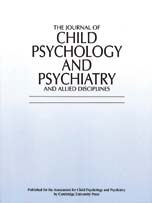Crossref Citations
This article has been cited by the following publications. This list is generated based on data provided by
Crossref.
Krueger, Robert F.
and
Carlson, Scott R.
2001.
Personality disorders in children and adolescents.
Current Psychiatry Reports,
Vol. 3,
Issue. 1,
p.
46.
Sonuga-Barke, Edmund J. S.
Dalen, Lindy
Daley, Dave
and
Remington, Bob
2002.
Are Planning, Working Memory, and Inhibition Associated With Individual Differences in Preschool ADHD Symptoms?.
Developmental Neuropsychology,
Vol. 21,
Issue. 3,
p.
255.
Berlin, Lisa
and
Bohlin, Gunilla
2002.
Response Inhibition, Hyperactivity, and Conduct Problems Among Preschool Children.
Journal of Clinical Child & Adolescent Psychology,
Vol. 31,
Issue. 2,
p.
242.
2003.
Do children's attention processes mediate the link between family predictors and school readiness?.
Developmental Psychology,
Vol. 39,
Issue. 3,
p.
581.
Peters Razza, Rachel
and
Blair, Clancy
2003.
False-Belief Understanding in a Low-Income Population.
Early Education & Development,
Vol. 14,
Issue. 4,
p.
425.
Lahey, Benjamin B.
2004.
Commentary: Role of Temperament in Developmental Models of Psychopathology.
Journal of Clinical Child & Adolescent Psychology,
Vol. 33,
Issue. 1,
p.
88.
Moore, Chris
and
Macgillivray, Shannon
2004.
Altruism, prudence, and theory of mind in preschoolers.
New Directions for Child and Adolescent Development,
Vol. 2004,
Issue. 103,
p.
51.
Foot, Hugh
Woolfson, Lisa
Terras, Melody
and
Norfolk, Claire
2004.
Handling Hard-to-Manage Behaviours in Pre-School Provision.
Journal of Early Childhood Research,
Vol. 2,
Issue. 2,
p.
115.
Dunn, Judy
2004.
Feelings and Emotions.
p.
303.
Espy, Kimberly Andrews
and
Bull, Rebecca
2005.
Inhibitory Processes in Young Children and Individual Variation in Short-Term Memory.
Developmental Neuropsychology,
Vol. 28,
Issue. 2,
p.
669.
Keenan, Kate
and
Hipwell, Alison E.
2005.
Preadolescent Clues to Understanding Depression in Girls.
Clinical Child and Family Psychology Review,
Vol. 8,
Issue. 2,
p.
89.
Marks, David J.
Berwid, Olga G.
Santra, Amita
Kera, Elizabeth C.
Cyrulnik, Shana E.
and
Halperin, Jeffrey M.
2005.
Neuropsychological correlates of ADHD symptoms in preschoolers..
Neuropsychology,
Vol. 19,
Issue. 4,
p.
446.
Hughes, Claire
and
Ensor, Rosie
2005.
Executive Function and Theory of Mind in 2 Year Olds: A Family Affair?.
Developmental Neuropsychology,
Vol. 28,
Issue. 2,
p.
645.
Weimer, Amy A.
and
Guajardo, Nicole R.
2005.
False Belief, Emotion Understanding, and Social Skills Among Head Start and Non-Head Start Children.
Early Education & Development,
Vol. 16,
Issue. 3,
p.
341.
OLSON, SHERYL L.
SAMEROFF, ARNOLD J.
KERR, DAVID C. R.
LOPEZ, NESTOR L.
and
WELLMAN, HENRY M.
2005.
Developmental foundations of externalizing problems in young children: The role of effortful control.
Development and Psychopathology,
Vol. 17,
Issue. 01,
Campbell, Anne
2006.
Sex differences in direct aggression: What are the psychological mediators?.
Aggression and Violent Behavior,
Vol. 11,
Issue. 3,
p.
237.
Riggs, Nathaniel R.
Jahromi, Laudan B.
Razza, Rachel P.
Dillworth-Bart, Janean E.
and
Mueller, Ulrich
2006.
Executive function and the promotion of social–emotional competence.
Journal of Applied Developmental Psychology,
Vol. 27,
Issue. 4,
p.
300.
Denham, Susanne A.
2006.
Social-Emotional Competence as Support for School Readiness: What Is It and How Do We Assess It?.
Early Education & Development,
Vol. 17,
Issue. 1,
p.
57.
Dadds, Mark R.
Perry, Yael
Hawes, David J.
Merz, Sabine
Riddell, Alison C.
Haines, Damien J.
Solak, Emel
and
Abeygunawardane, Amali I.
2006.
Attention to the eyes and fear-recognition deficits in child
psychopathy.
British Journal of Psychiatry,
Vol. 189,
Issue. 3,
p.
280.
Perren, Sonja
Stadelmann, Stephanie
von Wyl, Agnes
and
von Klitzing, Kai
2007.
Pathways of behavioural and emotional symptoms in kindergarten children: What is the role of pro-social behaviour?.
European Child & Adolescent Psychiatry,
Vol. 16,
Issue. 4,
p.
209.


